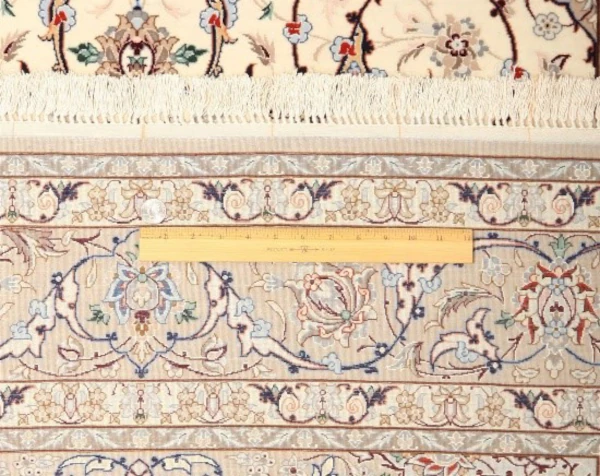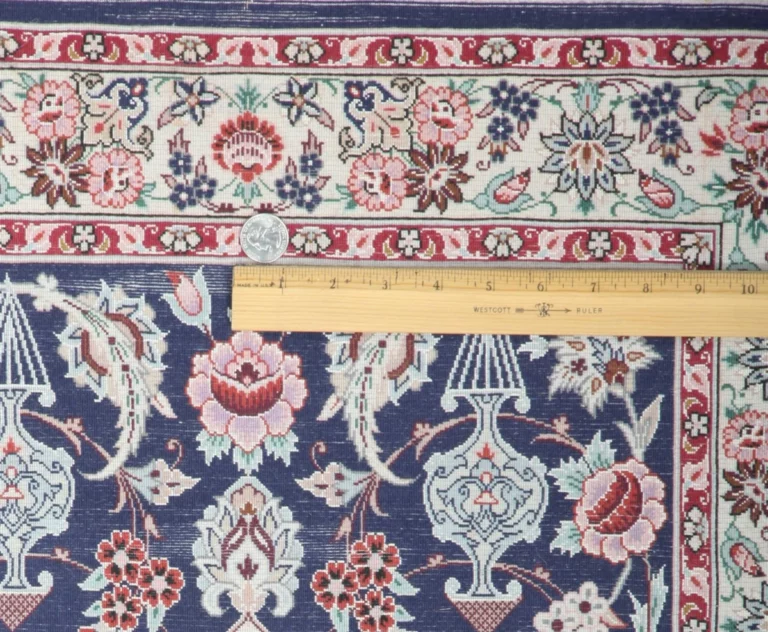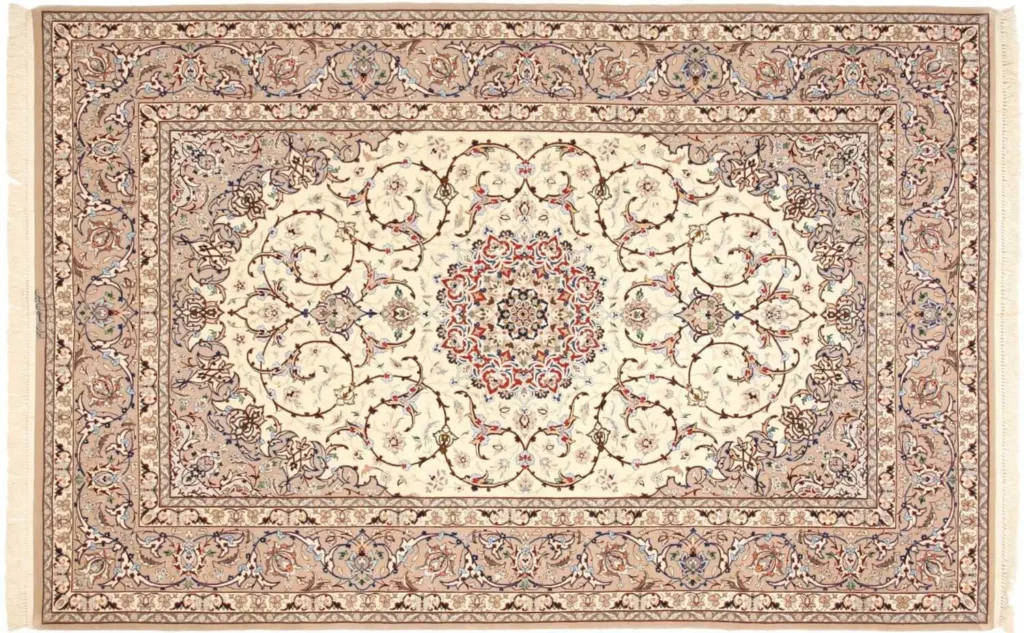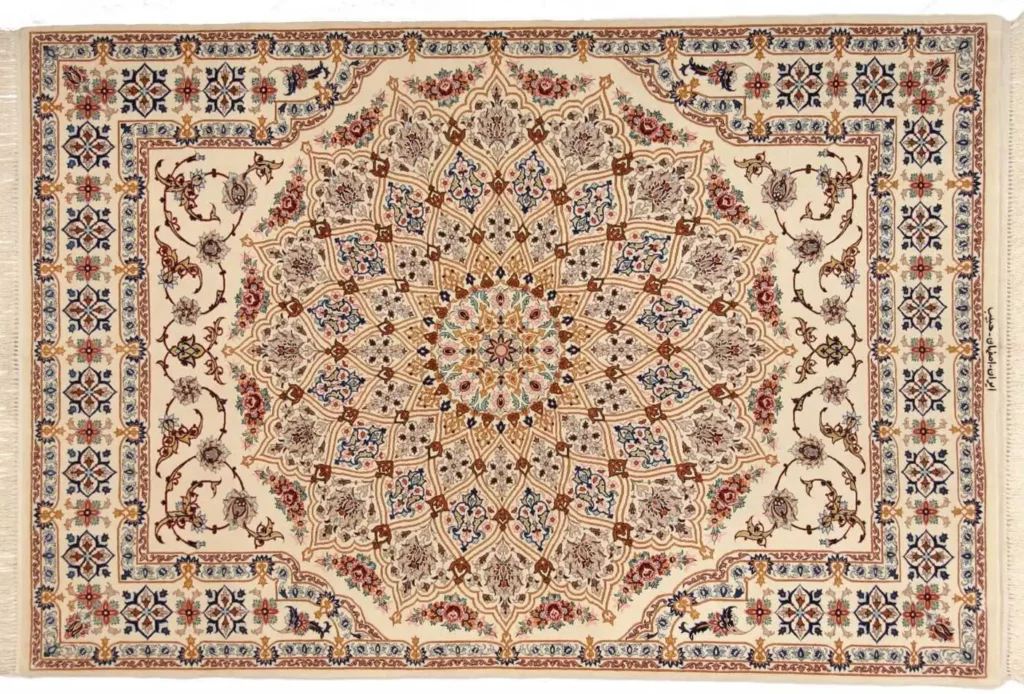Isfahan Rugs
Located in the middle of Persia, Isfahan has
maintained her great role of gathering all the
Iranian folks and their troops through the history.
The very geopolitical location made it the major
capital of the Safavid Shahs whose desire to
luxury has been woven amongst warps and wefts.
The evidences of pre-Safavid rugs are certain but
rare. Since Safavid Era, with the extension of rug
weaving in Iranian cities and villages, we could
see a great collection of Iranian rugs in a variety
of weaves, designs and colors, and amongst these
cities the Safavid capital has enjoyed the very
best of rug artisans.
With changing the capital from Qazvin to Isfahan
under the command of Shah Abbas the great
(1571-1629), the golden age of Iranian rug
weaving began. Isfahan has an appropriate
geopolitical situation and Shah Abbas believed
that the Iranian capital must be in the center of his
kingdom to get rid of Ottomans and Uzbeks
treats. He was fond of architecture, music,
painting and poetry and it is told that he himself
was a skillful rug weaver. He established several
royal rug weaving workshops in Isfahan. His own
palace was adorned with exquisite rugs and
among his political gifts rugs were of great
importance. One of the several rug workshops
had been located inside the Shah’s palace next to
the royal goldsmithery.
Rugs known as Polonez (Polish), which their production has been started
in the 16th century, have been burgeoned during
Shah Abbas time in the 17th century. The most
excellent ones have silken warp and wefts. The
naps are also silken with much more golden
threads than the 16th century’s.
In this period of time we could see a recognizable
improvement in the weave techniques. The
weave delicacy in one hand and the magnificent
designs and rich colors in the other hand, gave the
Safavid Isfahan rugs world-wide reputation.
People of Isfahan wove variant of silken and
gold-woven rugs during Safavid Era. At the time
Isfahan became a both domestic and international
center for rug trading.
Nowadays Isfahan has a population of
approximately 1.6 million. Handy crafts are still
popular between the people; and the most popular
one is rug, of course. Isfahan rug has the most
intact and original designs amongst Iranian urban
rugs. Isfahan retained its own patterns and
designs and still continues the Safavid style.

Technical aspects and the structure of Isfahan Rugs
Isfahan rugs are categorized under the title
“Workshop Rugs”. Workshop rugs are those
which are woven for sale, using loom-drawings.
Ordinary rugs in a workshop are woven from a
unique loom-drawing. Workshops are benefited
by fixed big looms, which made them able to
weave big-sized rugs. The appropriate warp
tension increases quality and helps weavers to
make sure about the final result from the
beginning. Workshop designs are mostly
curvilinear and more stylish. Both design and
weave are done accurately, so the edges are well-
ordered. Although workshop rugs lack
improvising, but most of them are benefited by a
classified type of elegance and materials of high quality, and some of them enjoy a high level of
artistic grace.
The raw materials of Isfahan rug are mostly fine
wool, fluff and silk. Using silken warp is a
characteristic of new-fashioned Isfahan rugs. The
delicacy of Isfahan rug’s design could only
represent on fine fibers. The common type of tie
in Isfahan and its surroundings is Persian
(asymmetrical tie). Knitting is completely with
hand (Isfahan’s weavers don’t use hook) and
polishing is done simultaneous with weaving
itself.

Dyeing and painting of Isfahan rugs
From the past Isfahan province has been an
important center of colorants plants’ cultivation,
especially rose madder. There are lots of wild
colorants plants in lands and mountains around
Isfahan and using them in Isfahan rug industry
was so common in the past. Now a day both
natural and chemical dyeing is common. For
custom-made and artistic rugs natural dyes are
desired. These dyes are taken mostly from indigo,
pomegranate peel, walnut hull, rose madder,
reseda and gundelia. Isfahan rug’s pallet is multicolored and a rug with
less than 14 colors is rare. The backgrounds are
usually turquoise, dark blue, red, beige and buff-
white.

Designs and patterns of the Isfahan rugs
Medallion is the most common sort of design
amongst Isfahan rugs, which is categorized as
quarter design (namely the main pattern repeats
symmetrically four times). Strong coherent
structure, with well-ordered segmentation,
congruous with traditional design’s rules, is the
main characteristic of medallion rugs.
The ratio of medallion and “Lachaks” to other
text’s patterns has the main importance. In
Isfahan’s medallion rugs this ratio is regarded
properly. In fact, Isfahan designers are
completely subordinate of mathematical
proportions, and as the result the medallion’s size
is always commensurate with the whole rug; not
too big and not too small. The medallion in
Isfahan rugs has always a standard size.

Medallions are mostly depicted circular in
Isfahan rugs. These medallions are drawn and
painted like layered shining suns. The layers next
to the center are more compressed and the layers
far from it are wider with bigger frames. The
frames separate medallion and Eslimi patterns.
Inside the frame is filled with Shah Abbasi
flowers and Xitai buds. There are two
medallion’s crests at the vertical sides of
medallion to make a gradual harmony between
medallion and ground in both color and form. The
junction between medallion and medallion’s crest
is usually a stylish Shah Abbasi flower or an
elaborate inscription.
In balance with their central medallion, Lachaks
of Isfahan rugs are always toric; never triangular
and never without curvature. Lachak’s total form
is important because it shapes the ground. The
toric Lachaks of Isfahan give an oval shape to the
grounds. Like medallion, Lachaks too are
layered. The layers are painted like their
medallions and in balance with the margin.
Eslimis are separating borders between Lachaks
and margin. Empty spaces between Eslimi lines
are mostly filled with faint colored Xitai flowers.
The ground’s atmosphere of Isfahan medallion
rug is formed gracefully by composition of Xitai
and Eslimi patterns. The rotations shape with
Xitai bands or a mixture of Xiati and Eslimi
bands. In second type one of the band groups is
painted fainter, mostly with a color relative to
ground’s color, to avoid amalgamation.

A specific Isfahan medallions is called Dome
Design, which has been taken from inner side of
the dome of Sheikh Lotfollah Mosque which
shines like a sun in Isfahan’s Naqhsh e Jahan
Square. Skillful designers of Isfahan have
depicted gracefully the dome’s inner decoration
as a big medallion on their rugs. In dome designs,
the medallion fills at least half of the ground;
sometimes its depicted layers extend to all over
the ground, being limited by the margin’s frame.


